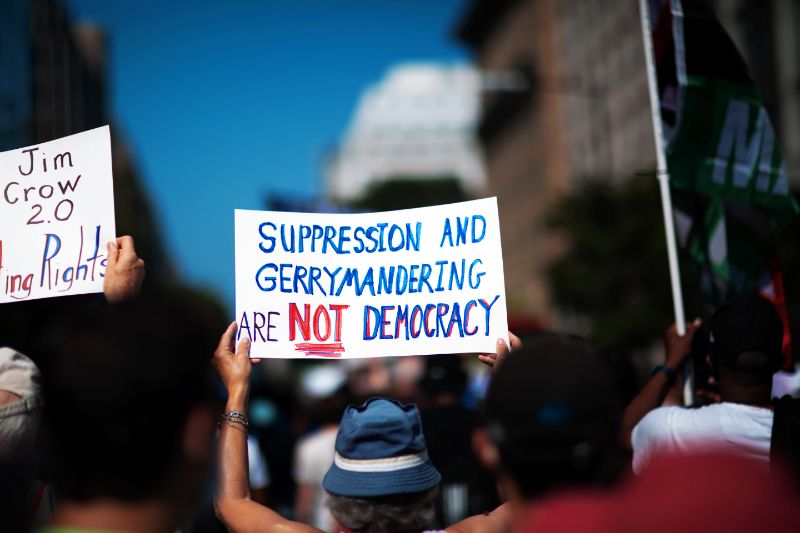Southern U.S. Redistricting: Ethnic Minority Voices Diluted
Voter suppression, voting rights restrictions, unfair representation! A recurring pattern in the current political climate of our nation. As Charles Mann uttered the words, “Democracy under attack,” all the panelists and journalists of this press briefing silently and woefully agreed.
In a press briefing hosted by Ethnic Media Services, speakers discuss the redistricting process in the southern United States. Although there aren’t any major shifts in the number of seats for states and districts, Michael Li of the Brennan Center for Justice warns that redistricting has reinforced existing gerrymanders in many states that are deeply biased against voters of color. Nowhere is this trend more pernicious than in the South, where communities of color account for almost all the population growth over the last decade.

Speakers
- Mitchell Brown, Voting Rights Counsel at Southern Coalition for Social Justice
- Deborah Chen, Esq., a community activist with OCA-Asian Pacific American Advocates
- Charles Mann, CROWD redistricting intern in South Carolina
- Sean Morales-Doyle, Acting Director, Democracy Program, Brennan Center for Justice
- Pilar Marrero, journalist and author, moderator
North Carolina
Mitchell Brown highlights the deliberate erosion of Black representation in the redistricting process of North Carolina. North Carolina, and most southern states, argue that their legislature didn’t utilize race as a factor in creating district lines and that redistricting can be done in a race-blind way. However, when looking at the maps, it seems that they are intentionally discriminatory and it’s clear that race and politics are intertwined in North Carolina.
The impact of these gerrymandering tactics will fall on communities of color. Ignoring Black, Latino, AAPI voters means diluting the voting strength of these voters. According to the 2020 Census, ethnic minority populations grew exponentially so one would assume better government representation of these communities. However, one look at the updated maps, and the picture is clear: voting voices are diluted and they can’t elect people that are responsive to the needs of their community. The ability to build coalitions is the key to getting a responsive government and when the legislature is trying to split communities apart and pit minority communities against each other, the communities’ voice in our Democracy weakens.
Texas
Deborah Chen chats about extreme gerrymandering in Texas and how it has locked out the state’s rapidly growing AAPI communities. Chen asserts that an entire coalition of different communities only asks the Texas legislature of one thing: transparency. All the coalition wants to know is the rationale behind maps, a proper timeline to see maps, and an opportunity to comment on maps. In an ideal situation, this would be the case – just look at California. The grim reality, portrayed by Chen, highlights the true intentions of Texas legislation with redistricting.
What actually happened: invites for public commentary were very vague with limited information about accessibility. The invites would be sent only 24-48 hours in advance with intangible information about how, where, and when the discussion might take place. Sometimes, the question was if there would be a public hearing for these maps and even then, the doors would be shut on communities of color. Describing a scene in one of the hearings, Chen recalls how people didn’t get the opportunity to get their voices heard. It seems as if people being called for input on the maps had non-ethnic names.
The result, like North Carolina and most southern states, is that the maps did not reflect on the population growth of communities of color, and districts were designed for more white representation.
South Carolina – Local Reform Movement
Charles Mann reflects on how grassroots activists are taking lessons learned from redistricting to win reform at local levels. Mann begins by reflecting on the redistricting process in South Carolina.
There are lawsuits in South Carolina on the maps created and the public sentiment is that the new maps stink. Mann pointed out that none of the democratic members, as redistricting committee members, were informed of the new changes to maps and there was a stronger republican influence on the maps. With that context set, Mann reflects on local-level activism for reform.
The first thing highlighted is education. Educating people on redistricting and its impact on their local communities is the first step to making a difference. Many citizens didn’t understand redistricting, but they do understand the importance of community. They understand relationships and the importance of their neighbors.
Mann shares the framework on the local level for redistricting reform. A local redistricting advisory committee, consisting of local coalitions from their respective county, comes together and asks, “What do we want our community to look like?” Bringing together the separate organizations led to a greater voice and a stronger will for action. Mann believes that even tough activists can’t grab the redistricting elephant, they can grab the tail, the ear, the trunk. Essentially, divide and conquer seems to be the best way to deal with redistricting reform. Amid the uncertainty, Mann follows one philosophy: Here are the actions that we can take, but we can’t control the result of those actions because there is no obligation from the people in power to hear their voice.
A Macro Lens – Brennan Center
Sean Morales-Doyle gives us a bigger picture of the tidal wave of restrictive voting laws. These are laws that encourage voter suppression and voice dilution. Laws that have not been seen in decades. Although redistricting doesn’t focus specifically on voting rights, both have a strong correlation.
Looking at the numbers, 19 states passed 34 laws restricting voting access and Brennan Center predicts that this unprecedented wave will continue in 2022. There have been restrictions enacted on voting by mail, for example. There are restrictions piled on top of old restrictions. One may argue that the 2020 US Election had a record voter turnout, however, a record turnout doesn’t equate to no voter suppression. According to Doyle, voting gaps are growing between Whites and communities of color. He warns that we are facing new threats on rights to vote, and Congress needs to act soon before this becomes a full-fledged “attack on our democracy.”


